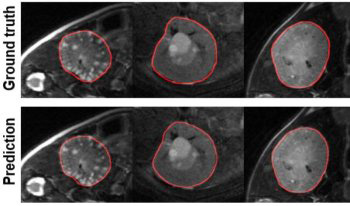
The aim of this work is to transfer the model trained on magnetic resonance images of human autosomal dominant polycystic kidney disease (ADPKD) to rat and mouse ADPKD models. A dataset of 756 MRI images of ADPKD kidneys was employed to train a modified UNet3+ architecture, which incorporated residual layers, switchable normalization, and concatenated skip connections for kidney and cyst segmentation tasks. The trained model was then subjected to transfer learning (TL) using data from two commonly utilized animal PKD models: the Pkdh1pck (PCK) rat and the Pkd1RC∕RC (RC) mouse. Transfer learning achieved Dice similarity coefficients of 0.93±0.04 and 0.63±0.16 (mean±SD) for a sample combination of PCK+RC kidneys and cysts, respectively, on the test datasets of animal images. We showcased the utilization of TL in situations involving constrained source and target datasets and have achieved good accuracy in the cases of class imbalance.